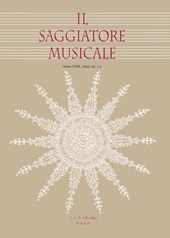Funzioni comunicative e dimensione retorica delle ripetizioni nell'aria tardo-settecentesca
P. 87-124
Repetition is a major rhetorical device in music. At the same time, it proves problematic in the hand to hand combat between poetry and music, which has always been an essential feature of Italian opera. In spoken theater, the first statement of a given line fulfills the speech-act, whereas in opera music requires repeats, vocal virtuosity, codas and cadences. Repetitions usually have a merely formal function; nevertheless, they may occasionally have a referential function and support the stage action. These issues are particularly interesting in the context of late 18th-century seria aria, especially in two-tempo rondò, and this for two reasons.
Firstly, rondos played a key role in the gradual shift from the 18th-century circular and ‘static' da capo aria to the 19th-century linear and dynamic multisectional aria. Secondly, the fast movement (stretta) is based on repetition itself, since it consists of a main theme (cabaletta), a linking section with previous verses (ponte) and the repeat of the cabaletta. The article discusses both two-tempo rondos and other late 18th-century aria forms and analyzes the rhetorical dimension and different functions of the various sections within the stretta. More specifically, it focuses on the linking section (ponte) within dynamic rondos, whose verses relate to a concrete stage action. In fact, the ponte can fulfil several different functions - referential, poetic, neutral - depending on how and which verses are sung. [Publisher's text]
-
Articles from the same issue (available individually)
-
Information
DOI: 10.1400/295214
ISSN: 2035-6706
DISCIPLINES


